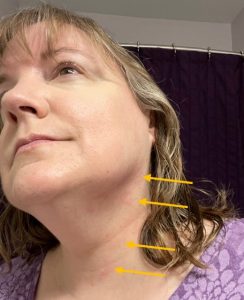Today let’s review some safety tips with essential oils, starting with my oopsie a few weeks ago.
Hot Oils
Some essential oils are casually referred to as “hot” oils – this simply means they are strong oils that could damage the skin if applied directly without a carrier oil.
A lot of the spice oils are in this category.
I recommend diluting hot oils with your favorite carrier oil whenever using them topically.
As a real-life example, I was opening my bottle of cinnamon oil and it fell on the floor. I reached down to pick it up and when I stood up, I brushed my hair out of my face with my hand.
Within a minute or so, I started feeling a burn all along one side of my neck and realized I must have had oil on my fingers when I did that.
It turned bright red and the burning intensified quickly.
What to do if you get a hot oil on your skin
It’ll be so uncomfortable that you will most likely catch this quickly.
- Immediately wash the area with soap and water
- Then apply a plain carrier oil to the skin, whatever you have on hand – for example, fractionated coconut oil, jojoba oil, almond oil, even olive oil or fragrance-free lotion.
Usually that’s all it takes to soothe, but repeat another round of the steps above if you need to.

Here is a picture taken about 5 to 10 minutes afterwards. I was too busy applying first aid to take a picture of it right away.
But you can see from this how quickly it resolves if you take care of it immediately.
List of Hot Oils to Dilute
This is not an exhaustive list, just the more commonly used oils that need to be diluted before using topically:
| Basil | Black Pepper |
| Cassia | Cinnamon |
| Citronella | Clove |
| Fennel | Ginger |
| Lemon Eucalyptus | Lemongrass |
| Lemon Myrtle | Marjoram |
| On Guard | Oregano |
| Peppermint | Thyme |
| Vetiver | Wintergreen |
Sun Photosensitive Oils
The second caution category for essential oils is photosensitivity.
These oils can damage your skin if you put them on undiluted or insufficiently diluted before going out into the sun.
Do not apply on sun exposed areas up to 12 hours prior to going out in the sun. (some texts will even say 18 hours.)
IMPORTANT: if you get an oil burn from the sun, it is not so quickly resolved as my hot oil example above. It may take days to resolve, so please be safe with these oils.
How to soothe a photosensitive reaction
This is more severe than a hot oil irritation, so treat it as you would a burn.
You can apply aloe vera and/or lavender + tea tree with a carrier oil for a minor discomfort.
If slightly more damaged, use a first aid burn cream.
If a severe burn, go to immediate care.
For those who like to create with their oils, each oil below does have a safe percentage it can be diluted to not create a sun reaction.
However, for some oils, it’s very small. For example, Bergamot, Mandarin, and cold-pressed Lime are the most photosensitive, so a safe dilution would be less than 1 drop in a 10mL roller.
Because of the tiny acceptable amounts, it’s easier to apply these oils to non-exposed areas – under clothes, under hair, etc. Or keep them to evening use.
Photosensitive Single Oils
Bergamot
Grapefruit
Mandarin (Green, Red, or Yellow)
Laurel
Lemon
Lime *
Tangerine
Wild Orange**
*cold-pressed Lime (the most commonly one used) is photosensitive but distilled Lime is not.
**Wild Orange is technically not photosensitive but it is easier and safer to treat it the same as the others.
Photosensitive Blends
AromaTouch
Breathe
Cheer
Citrus Bliss
Forgive
Motivate
On Guard
Purify
Slim & Sassy
Zendocrine
My two rules to make it easier…
When in doubt, dilute.
When in doubt, keep oils under clothing.
This post may contain affiliate links, meaning I may receive a commission (at no extra cost to you) if you use that link to make a purchase. See my disclaimer.
Is Three Wells right for you?
Get a free 15 minute Q&A consultation to find out!
